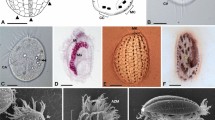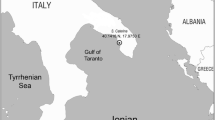Abstract
Species of Isorropodon are vesicomyid bivalves for which little information is available regarding host phylogeny and bacterial symbioses. In this study we investigated the symbioses in three Isorropodon species from three cold seep areas: Isorropodon bigoti (Gulf of Guinea), Isorropodon megadesmus (Gulf of Cadiz) and Isorropodon perplexum (Eastern Mediterranean). Analysis of bacterial 16S ribosomal RNA gene sequences demonstrated that each vesicomyid species harbours a single symbiont phylotype, that symbionts from the three species cluster together, and that they are closely related to other known vesicomyid symbionts. These results are confirmed by other marker genes (encoding 23S rRNA and APS reductase) and by fluorescence in situ hybridization. Due to their extended depth range and transoceanic distribution Isorropodon species are interesting examples to further study evolutionary processes in bivalve hosts and their associated symbionts.



Similar content being viewed by others
References
Allen JA (2001) The family Kelliellidae (Bivalvia: Heterodonta) from the deep Atlantic and its relationship with the family Vesicomyidae. Zool J Linn Soc-Lond 131:199–226
Altschul SF, Madden TL, Schaeffer AA, Zhang J, Zhang Z, Miller W, Lipman DJ (1997) Gapped BLAST and PSI-BLAST: a new generation of protein database search programs. Nucleic Acids Res 25(17):3389–3402
Amano K, Kiel S (2007) Fossil vesicomyid bivalves from the North Pacific region. Veliger 49:270–293
Baco AR, Smith CR, Peek AS, Roderick GK, Vrijenhoek RC (1999) The phylogenetic relationships of whale-fall vesicomyid clams based on mitochondrial COI DNA sequences. Mar Ecol Prog Ser 182:137–147
Carlier A, Ritt B, Rodrigues CF, Sarrazin J, Olu K, Grall J, Clavier J (2010) Heterogeneous energetic pathways and carbon sources on deep eastern Mediterranean cold seep communities. Mar Biol 157(11):2545–2565
Cary SC, Giovannoni SJ (1993) Transovarial inheritance of endosymbiotic bacteria in clams inhabiting deep-sea hydrothermal vents and cold seeps. Proc Natl Acad Sci 90:5695–5699
Cole JR, Chai B, Marsh TL, Farris RJ, Wang Q, Kulam SA, Chandra S, McGarrell DM, Schmiedl TM, Garrity GM, Tiedje JM (2003) The Ribosomal Database Project (RDP-II): previewing a new autoaligner that allows regular updates and the new prokaryotic taxonomy. Nucleic Acids Res 31(1):442–443
Cosel RV, Olu K (2009) Large Vesicomyidae (Mollusca: Bivalvia) from cold seeps in the gulf of Guinea off the coasts of Gabon, Congo and northern Angola. Deep-Sea Res II 56:2350–2379
Cosel RV, Salas C (2001) Vesicomyidae (Mollusca: Bivalvia) of the genera Vesicomya, Waisiuconcha, Isorropodon and Callogonia in the eastern Atlantic and the Mediterranean. Sarsia 86(4–5):333–366
Decker C, Olu K, Cunha RL, Arnaud-Haond S (2012) Phylogenetic relationships among cold-seep vesicomyid bivalves from the Gulf of Guinea and their western Atlantic and Pacific counterparts. PLoS One 7(4):e33359. doi:10.1371/journal.pone.0033359
Dubilier N, Bergin C, Lott C (2008) Symbiotic diversity in marine animals: the art of harnessing chemosynthesis. Nat Rev Microbiol 5:725–740
Duggen S, Hoernie K, van den Bogaard P, Rupke L, Phipps Morgan J (2003) Deep roots of the Messinian salinity crisis. Nature 422:602–606
Duperron S, Fiala-Medioni A, Caprais JC, Olu K, Sibuet M (2007) Evidence for chemoautotrophic symbiosis in a Mediterranean cold seep clam (Bivalvia-: Lucinidae): comparative sequence analysis of bacterial 16S rRNA, APS reductase and RubisCO genes. FEMS Microbiol Ecol 59:64–70
Duperron S, Halary S, Lorion J, Sibuet M, Gaill F (2008) Unexpected co-occurrence of six bacterial symbionts in the gills of the cold seep mussel Idas sp. (Bivalvia: Mytilidae). Environ Microbiol 10 (2):433–445
Felsenstein J (1993) PHYLIP (phylogeny inference package) 3.57c edn. Department of Genetics, University of Washington, Seattle
Fisher CR (1990) Chemoautotrophic and methanotrophic symbioses in marine invertebrates. Rev Aquat Sci 2(3,4):399–436
Fujiwara Y, Kojima S, Mizota C, Maki Y, Fukikura K (2000) Phylogenetic characterization of the endosymbionts of the deepest-living vesicomyid clam, Calyptogena fossajaponica, from the Japan Trench. Venus Jap Jour Mal 59(4):307–316
Garcia-Merchan VH, Robainas-Barcia A, Abelló P, Macpherson E, Palero F, Garcia-Rodriguez M, Gil de Sola L, Pascual M (2012) Phylogeographic patterns of decapod crustaceans at the Atlantic-Mediterranean transition. Mol Phylogenet Evol 62:664–672
Goffredi SK, Hurtado LA, Hallam S, Vrijenhoek RC (2003) Evolutionary relationships of deep-sea vent and cold seep clams (Mollusca: Vesicomyidae) of the “pacifica/lepta” species complex. Mar Biol 142:311–320
Hammer T, Harper DAT, Ryan PD (2001) PAST: paleontological statistics software package for education and data analysis. Palaeontol Electron 4:1–9
Harada M, Yoshida T, Kuwahara H, Shimamura S, Takaki Y, Kato C, Miwa T, Miyake H, Maruyama T (2009) Expression of genes for sulfur oxidation in the intracellular chemoautotrophic symbiont of the deep-sea bivalve Calyptogena okutanii. Extremophiles 13(6):895–903
Hurtado LA, Mateos M, Lutz RA, Vrinjenhoek RC (2003) Coupling of bacterial endosymbiont and host mitochondrial genomes in the hydrothermal vent clam calyptogena magnifica. Appl Environ Microbiol 69(4):2058–2064
Imhoff JF, Sahling H, Suling J, Kath T (2003) 16S rDNA-based phylogeny of sulphur-oxidising bacterial endosymbionts in marine bivalves from cold-seeps environments. Mar Ecol Prog Ser 249:39–51
Kim Y, Yasuda M, Yamagishi A, Oshima T, Ohta S (1995) Characterization of the endosymbiont of a deep-sea bivalve Calyptogena soyoae. Appl Environ Microbiol 61(2):823–827
Kojima S, Kobayashi T, Hashimoto J, Ohta S (1995) RFLP analysis of a mitochondrial gene, Cytochrome Oxidase I (COI) of three species of the genus Calyptogena around Japan. J Oceanogr 51:257–259
Kojima S, Fujikura K, Okutani T (2004) Multiple trans-Pacific migrations of deep-sea vent/seep endemic bivalves in the family Vesicomyidae. Mol Phylogenet Evol 32:396–406
Kojima S, Tsuchida E, Numanami H, Fujikura K, Okutani T (2006) Synonymy of Calyptogena solidissima with Calyptogena kawamurai (Bivalvia: Vesicimyidae) and its popularion structure revealed by mitochondrial DNA sequences. Zool Sci 23:835–842
Krylova EM, Sahling H (2010) Vesicomyidae (Bivalvia): current taxonomy and distribution. PLoS One 5(4):e9957
Krylova EM, Gebruk AY, Portnova DA, Todt C, Haflidason H (2011) New species of the genus Isorropodon (Bivalvia: Vesicomyidae: Pliocardiinae) from cold methane seeps at Nyegga (Norwegian Sea, Voring Plateau, Storrega slide). J Mar Biol Assoc UK 91(5):1135–1144
Kuwahara H, Takaki Y, Yoshida T, Shimamura S, Takishita K, Reimer J, Kato C, Maruyama T (2008) Reductive genome evolution in chemoautotrophic intracellular symbionts of deep-sea Calyptogena clams. Extremophiles 12(3):365–374
Lane DJ (1991) 16S/(23S rRNA sequencing. In: Stakebrandt E, Goodfellow M (eds) Nucleic acid techniques in bacterial systematics. Wiley, New York, pp 115–175
Meyer B, Kuever J (2007) Molecular analysis of the distribution and phylogeny of dissimilatory adenosine-59-phosphosulfate reductase-encoding genes (aprBA) among sulfuroxidizing prokaryotes. Microbiol 153:3478–3498
Okutani T, Fujikura K, Kojima S (2000) New taxa and review of vesicomyid bivalves collcted from the northwest Pacific by deep-sea research systems of Japan Marine Science & Technology Center. Venus Jap Jour Mal 59:83–101
Oliver PG, Rodrigues CF, Cunha MR (2011) Chemosymbiotic bivalves from the mud volcanoes of the Gulf of Cadiz, NE Atlantic, with descriptions of new species of Solemyidae, Lucinidae and Vesicomyidae. Zookeys 113:1–38
Olu-Le Roy K, Sibuet M, Fiala-Médioni A, Gofas S, Salas C, Mariotti A, Foucher JP, Woodside J (2004) Cold seep communities in the deep eastern Mediterranean Sea: composition, symbiosis and spatial distribution on mud volcanoes. Deep-Sea Res I 51:1915–1936
Osborn M (2001) Molecular systematics of the vesicomyid clams: Calyptogena kilmeri and Vesicomya gigas. MBARI report. pp 7
Peek AS, Gustafson RG, Lutz RA, Vrijenhoek RC (1997) Evolutionary relationships of deep-sea hydrothermal vent and cold-water clams (Bivalvia: Vesicomyidae) results from the mitochondrial cytochrome oxidase subunit I. Mar Biol 130:151–161
Peek AS, Feldman RA, Lutz RA, Vrijenhoek RC (1998) Cospeciation of chemoautotrophic bacteria and deep-sea clams. Proc Natl Acad Sci 95:9962–9966
Peek AS, Gaut BS, Feldman RA, Barry JP, Kochevar RE, Lutz RA, Vrijenhoek RC (2000) Neutral and Nonneutral Mitochondrial Genetic Variation in Deep-Sea Clams from the Family Vesicomyidae. J Mol Evol 50 (2):141–153
Ronquist F, Huelsenbeck JP (2003) MrBayes 3: Bayesian phylogenetic inference under mixed models. Bioinformatics 19(2):1572–1574
Stewart FJ, Cavanaugh CM (2009) Pyrosequencing analysis of endosymbiont population structure: co-occurrence of divergent symbiont lineages in a single vesicomyid host clam. Environ Microbiol 11(8):2136–2147
Stewart FJ, Young CR, Cavanaugh CM (2008) Lateral symbiont acquisition in a maternally transmitted chemosynthetic clam endosymbiosis. Mol Biol Evol 25(4):673–687
Stewart FJ, Young CR, Cavanaugh CM (2009) Evidence for homologous recombination in intracellular chemosynthetic clam. Mol Biol Evol 26(6):1391–1404
Sturany R (1896). Zoologische Ergebnisse VII. Mollusken I (Prosobranchier und Opisthobranchier; Scaphopoden; Lamellibranchier) gesammelt von S.M. Schiff “Pola” 1890-1894. Denkschriften der Kaiserlichen Akademie der Wissenschaften, Mathematische-Naturwissenschaftlischen Classe 63:1–36, pl.1–2
Taviani M (1994) The “calcari a Lucina” macrofauna reconsidered: deep-sea faunal oases from Miocene-age cold vents in the Romagna Apennine, Italy. Geo-Mar Lett 14:185–191
Thiele J, Jaeckel S (1931) Muscheln der Deutschen Tiefsee Expedition. Wissenschaftliche Ergebnisse der Deutschen Tiefsee Expedition 1898–1899 21:159–268
Thompson JD, Gibson TJ, Plewniak F, Jeanmougin F, Higgins DG (1997) The Clustal X-Windows interface: flexible strategies for multiple sequence alignments aided by quality analysis tools. Nucleic Acids Res 25(24):4876–4882
Zielinski FU, Pernthaler A, Duperron S, Raggi L, Giere O, Borowski C, Dubilier N (2009) Widespread occurrence of an intranuclear bacterial parasite in vent and seep bathymodiolin mussels. Environ Microbiol 11(5):1150–1167
Acknowledgments
Thanks are due to the chief-scientists and crew of the several cruises were specimens were collected: TTR17 Leg 2 (Gulf of Cadiz, RV Logatchev): Luis Pinheiro (Departamento de Geociências, Universidade de Aveiro) and Michael Ivanov (Moscow State University); MSM13/4 (Eastern Mediterranean; RV MS Merian, ROV Quest): Antje Boetius and Frank Wenzhofer (Max Planck Insittute); WACS (Gulf of Guinea; RV Pourquoi Pas?, ROV Victor 6000). The authors are indebted to Nelly Leger of the team AMEX (UPMC) for her help in the lab. Finally we are grateful to the two anonymous reviewers and the editor Dr. Charles Fisher for their constructive and helpful comments.
This research was supported by the European Commission Seventh Framework Programme (FP7/2007-2013) under the HERMIONE project contract 226354, French ANR DeepOases, GDRE—DIWOOD and CHEMECO ESF EURODEEP (FCT; EURODEEP/0001/2007). CFR was also supported by a post-doctoral fellowship (SFRH/BPD/64154/2009) from the Fundação para a Ciência e a Tecnologia (FCT, Portugal).
Author information
Authors and Affiliations
Corresponding author
Rights and permissions
About this article
Cite this article
Rodrigues, C.F., Cunha, M.R., Olu, K. et al. The smaller vesicomyid bivalves in the genus Isorropodon (Bivalvia, Vesicomyidae, Pliocardiinae) also harbour chemoautotrophic symbionts. Symbiosis 56, 129–137 (2012). https://doi.org/10.1007/s13199-012-0168-0
Received:
Accepted:
Published:
Issue Date:
DOI: https://doi.org/10.1007/s13199-012-0168-0




